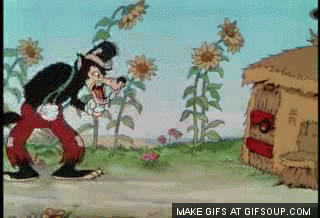
Michael Spurlin's Reading Design Lessons
Reading to Learn: Who Do You Believe?
Rationale:
This lesson is designed to introduce students to the author’s point of view and they will experience that by reading two different versions of the same story. The story is The Three Little Pigs and they will read a version told by Mr. Wolf and by the three pigs. We will discuss the meaning of point of view and how the author uses it to tell stories while reading the two different accounts of the same story. The students will have to use the facts and information from the stories to support who they decide to believe whether that be the wolf or the pigs.
Materials:
5 copies of The True Story of the Three Little Pigs by: Jon Scieszka
Paper and Pencils
Reading Journals
Procedures:
-
We will begin by reviewing the story of the Three Little Pigs that we all know. What happened in this story? The wolf blew the pig’s house down moving from the first pig who used straw, the second who used sticks, and the third who used bricks.
-
Review point of view with students and how the author uses it to show different characters in the story. Read The True Story of the Three Little Pigs as a group and have different voices for different characters in the story to show the different point of view for each.
-
Discuss the main idea of the story and who’s point of view was the story told. The main idea was that the wolf was not actually a bad guy, that he was telling his side of the story and what really happened was that he wanted to borrow a cup of sugar the whole time. Whose point of view was this story from? The Wolf. How can we tell? Because he was telling his story.
-
Review the original story of The Three Little Pigs and how the wolf is described as being mean, hungry, and huffing and puffing. Now compare that to The True Story of the Three Little Pigs where the wolf describes himself as being actually very nice and how he was just sneezing. Explain how the same thing is being interpreted two different ways from two different points of view.
-
Students will now create Venn Diagrams that compare and contrast the two stories and the different points of view from the story tellers. The teacher will model how the Venn diagram should look and how it should be used with each story.
-
Students will now write an entry in their reading journals and using the evidence and facts they found in the two different stories they will write about who they believe and which story they feel is true. They will write using text evidence to support their claims of which they feel is true and share details from the point of view they believe.
-
The teacher can review their Venn diagrams and journal entries to assess for understanding of point of view and use of text evidence to support their claims.
References:
Lesson ideas from http://alex.state.al.us/standardAll.php?subject=ELA2015&summary=1
The True Story of the Three Little Pigs by: Jon Scieszka
Assessment ideas from http://alex.state.al.us/lesson_view.php?id=33436
